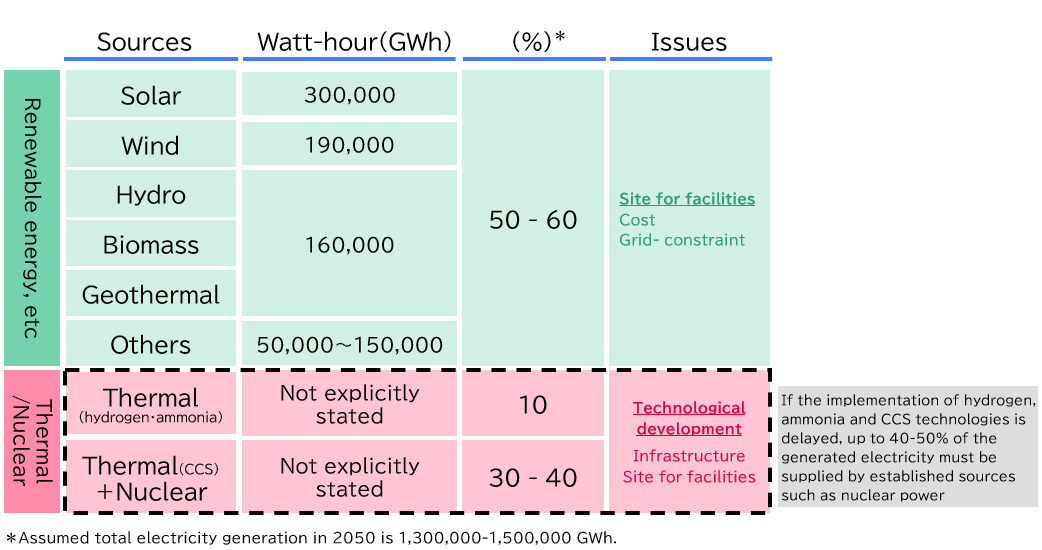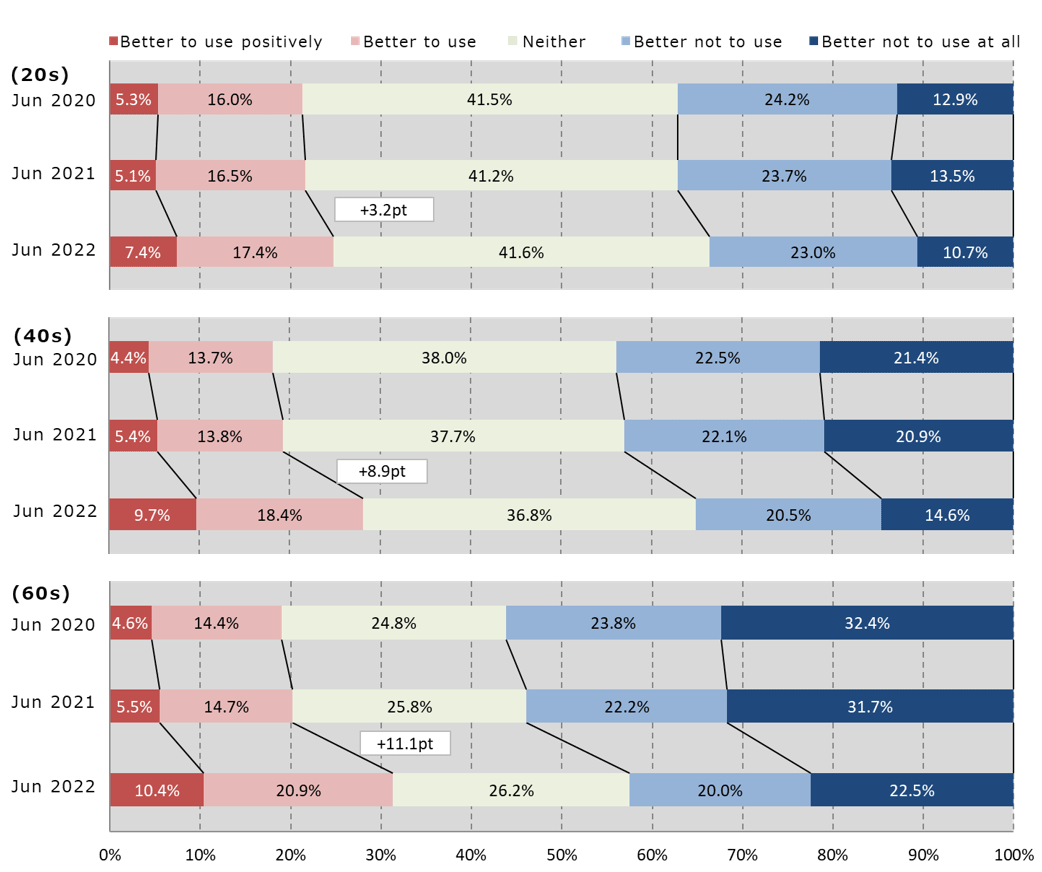Recommendations on Long-term Use of Nuclear Energy in a Carbon-Neutral Japan
Energy risks revealed around the world: accelerating the move toward decarbonization and energy security at the same time
On November 4, 2022, we published the English version of our Social and Economic Impacts of Carbon Neutrality in 2050 report. The report defined four scenarios for Japan’s future through 2050 and proposed the direction that measures should take to achieve a smooth transition to a decarbonized society. This report states the importance of making clear that nuclear power will play a role in Japan’s long-term energy strategy. It elaborates on the need for Japan to maintain its nuclear-power related technologies and human resources, and innovate in nuclear power itself. The report speaks to the potential for using nuclear power in harmony with the large-scale uptake of renewable energy.
1:The EU taxonomy is a classification system, establishing a list of environmentally sustainable economic activities.
Securing diverse power supply is key for Japan: government takes step to build new plants
2:A meeting chaired by the Prime Minister to consider measures necessary to implement the transformation of the entire economic and social system, namely, GX (Green Transformation), by shifting the fossil-fuel-centric economic, social, and industrial structure present since the Industrial Revolution to one that is clean-energy centric.
Nuclear energy is an effective option: maintaining the domestic economy and industry, achieving reliable carbon neutrality, and guaranteeing a stable energy supply
Japan is now at a crossroads as to whether to include nuclear power as an option in its future energy mix. Japan needs to make swift progress in many venues: the maximum introduction of renewable energy accompanied by the development of innovative technologies such as solar and wind power generation and storage batteries; energy saving and electrification on the demand side; decarbonization of thermal power such as fuel conversion to hydrogen and ammonia; CCS (carbon dioxide capture and storage); and DAC (direct air capture). Yet there are challenges and uncertainties in the implementation of each of these.
As a response to this uncertainty, the use of nuclear energy, which has a technical track record, does not emit carbon dioxide when generating electricity, and is regarded as quasi-domestic energy, is an effective option. The ideal way of using nuclear power should be clarified based on both the risks inherent in nuclear power that cannot be completely eliminated and the risks that could arise in the face of uncertainty surrounding carbon neutrality and energy security in the case that nuclear power is not used.
We propose the following plan for the long-term use of nuclear energy.
- Short-term: restart existing nuclear power plants that meet regulatory standards to contribute to the stable supply of electricity
- Medium-term: sustain use of nuclear power until 2050—the only practical solution
- Long-term: re-examine policy on the use of nuclear power for 2050 onward based on the outlook around 2040 for alternative decarbonization technologies and security trends
- Additional considerations: as a tangible option moving forward, nuclear innovation should be promoted to the same degree as other technologies like hydrogen, ammonia, and CCS
If the future of nuclear energy is left to ambiguity now, its technology, human resources, and supply chain will be weakened and difficult to sustain until 2050. Without action, we risk losing the promising option of nuclear energy altogether.
Maintaining a base that enables nuclear power to account for at least 10 - 15% of power generation as of 2050
Policy on the use of nuclear energy after 2050 needs to be reconsidered around 2040 in light of developments in other decarbonizing technologies, including further expansion of nuclear energy use itself if necessary, and the option of post-nuclear power, in other words stopping the use of nuclear power altogether. If a post-nuclear power scenario is a viable option around 2040, society will then be able to redefine how power plants in operation, under construction, or planned at the time should be used in order to make the option a reality.
3:Mitsubishi Research Institute, Inc. “Report on the domestic and foreign nuclear industry”,
https://www.meti.go.jp
4:The Japan Electrical Manufactures’ Association "4th Nuclear Subcommittee on Maintenance of Nuclear Technology and Human Resources",
https://www.meti.go.jp
Nuclear innovation as a long-term power option
Social acceptance of nuclear power is on the rise, but continuous efforts to improve safety and build trust are essential
Based on the recognition that safety and trust are different, we should focus on steady activities to foster trust
Trust has three main aspects. The first is competence, such as the ability of the nuclear industry to use nuclear technology safely. The second is motivation, such as whether the nuclear power industry complies with regulations and conducts business activities fairly and honestly. The third is value similarity, such as whether organizations and individuals in the nuclear power industry view the world from the same point of view as the rest of society, and whether the industry responds to the needs and wishes of society. Our own questionnaire survey on trust, conducted separately with 4,700 people nationwide, revealed that value similarity had a particularly strong influence in cases such as trust in the nuclear industry (Supplement 3). In other words, whether or not the nuclear power industry can properly understand and respond to society's wishes from the same point of view as society is important in building trust. On the other hand, public opinion spans the full spectrum from prioritizing safety above all else, to requests for electricity that is both inexpensive and stable. In light of this, the nuclear industry should not focus on measures aimed at building trust just for show, but rather on steady efforts to understand the thoughts and values of society and to demonstrate a willingness to respond appropriately to each. In other words, perfunctory initiatives that do not involve internal or substantive changes in the nuclear industry, such as changing the organization without changing the mindset of following precedent, will not foster trust. It goes without saying that the industry must make voluntary, autonomous, and continuous efforts to improve safety based on incorporating the latest knowledge and technological developments. The first step toward building trust should be to continuously demonstrate that as an industry all are sincere in efforts to accurately understand and appropriately respond to the diverse thoughts and values of society.
Existing and dormant issues must be resolved
These recommendations mark the start of continued work from the Mitsubishi Research Institute to conduct further research and form subsequent recommendations in fully addressing these important issues.
Supplement
Supplement 1: Electricity supply outlook as of 2050 aimed at achieving carbon neutrality
- National councils in Japan are discussing issues and initiatives assuming that, as of 2050, 50 - 60% of the energy will come from renewable sources and the rest from decarbonized thermal and nuclear power
- Considering the uncertainty of technological development related to decarbonized thermal power (hydrogen, CCS, etc.), it is necessary for nuclear power, etc. to shoulder 40 - 50% of the energy mix

5:Agency for Natural Resources and Energy, Study on Achieving Carbon Neutrality in 2050, May 13, 2021,
https://www.enecho.meti.go.jp
Supplement 2: Time series changes in the social acceptance of nuclear energy (our original questionnaire survey)
- According to the results of a survey conducted via our consumer market forecasting system mif (FY 2022)6, the percentage of respondents who said it was better to use nuclear power positively and that it was better to use nuclear power increased in each age group over the past two years
- Conversely, "better not to use" and "better not to use at all" declined in all age groups
6:Mitsubishi Research Institute's Consumer Market Forecast System (mif) 2022 Basic Survey
(Region: Nationwide, Target: Male and female, 20 - 69 years old, Method of survey: Web survey, Number of participants: 30,000, When: June 2022)

Supplement 3: Our nation-wide questionnaire on the three aspects of trust
Implementation method:
- We surveyed a total of 4,700 citizens (100 from each prefecture) and measured their trust in nine nuclear power entities7 using a questionnaire
- We used the assumption that trust is comprised of three aspects: competence, motivation, and value similarity,8 and set questions on a five-point scale, from “think so” to “don't think so”
Results:
- Trust in nuclear power operators and manufacturers is at a moderate level among the nine entities
- For all entities, value similarity has the strongest influence on trust, but value similarity is particularly prominent for nuclear power operators and manufacturers


7:Entities: research and international organizations, experts, nuclear power operators and manufacturers, host municipalities, the Nuclear Regulation Authority, the Ministry of Economy, Trade and Industry and the Agency for Natural Resources and Energy, the mass media, the courts and the Diet
8:Kazuya Nakayachi, 'The Classroom of Trust Studies' (Kodansha Gendai Shinsho), 2015
For Inquiry
Mitsubishi Research Institute, Inc.
10-3 Nagatacho 2-chome, Chiyoda-ku, Tokyo 100-8141, Japan
Email: ssu-inquiry@ml.mri.co.jp
